Apps
Auto Added by WPeMatico
Auto Added by WPeMatico
With a new feature called Yelp Connect, Yelp is allowing users to go beyond customer reviews and see “what the restaurants have to say for themselves.”
That’s according to Devon Wright, Yelp’s general manager of restaurant marketplaces. He explained that with Yelp Connect, restaurants will be able to post updates about things like recent additions to the menu, happy hour specials and upcoming events. These updates are then shown on the Yelp homepage (which is already becoming more personalized), in a weekly email and on the restaurant’s profile page.
Consumers, meanwhile, can follow restaurants to see these updates, but Yelp also shows them to users who have indicated interest in a restaurant by making a reservation, joining its waitlist or bookmarking its profile.
Of course, restaurants are already posting this kind of information on social media, but Wright said Yelp allows them to reach “a high-intent audience” — people who aren’t just browsing for updates from their friends, but are actually looking to go out for a meal.
Guang Yang, the group product manager for Yelp Reservations and Waitlist, also noted that restaurants can set end dates for their Yelp posts, which could make them more comfortable sharing things like limited-time menus.
Yelp Connect will cost $199 per month for U.S. restaurants, but is available for a limited time at a price of $99 per month.
Wright described this is part of a broader evolution at Yelp, where “you don’t just want to discover a great restaurant, you want to transact [with] that restaurant.” So the company has added things like reservations, with Connect serving as “the final piece of that journey,” allowing restaurants to continue reaching out to consumers after their visit.
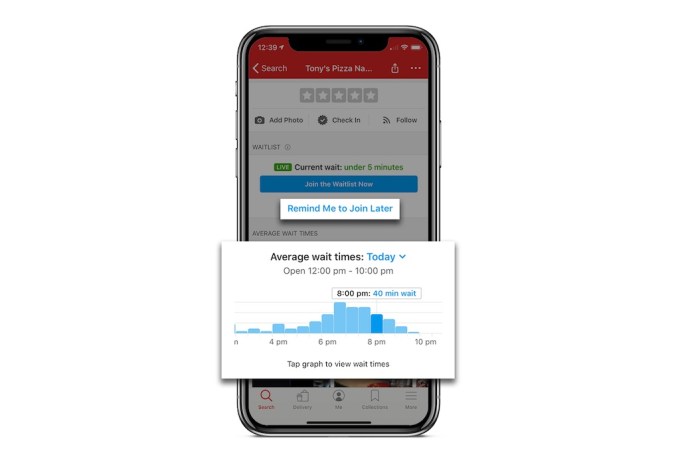
In addition to launching Connect, Yelp is also announcing an upgrade to its Waitlist feature, which allows consumers to see the current estimated wait time at a restaurant, and to join the queue directly from the Yelp app.
Yang said Yelp can now use real wait time data from a restaurant to predict the average wait at a given time — so if you want to get dinner tonight at 7pm, Yelp can tell how long you’ll probably have to wait. (These estimates are based on a party size of two; you’ll enter your real party size and get an updated estimate when you actually join the waitlist.)
Yelp is also using these predictions to power an additional feature called Notify Me. If you want to get seated at a certain restaurant at a certain time, you can hit a button to get a notification that will prompt you to join the waitlist at the right time — if you want to eat at 7pm, and the average wait time at 7pm is an hour, then you’ll get a notification at 6pm.
Yang said the algorithm is “pretty sophisticated,” and even incorporates some of the common situations that can confound these estimates, like kitchen closing times, or popular restaurants that have long a waitlist as soon as they open.
Still, he acknowledged that there will be times when the actual is different from what’s predicted, which may be challenging when you’ve told all your friends to meet you somewhere at a given time. But in those cases, he said most restaurants “acknowledge and understand, ‘Oh, something happened, wait time changed,’ ” and they’ll make accommodations if you show up later.
Powered by WPeMatico
French startup Zyl has raised $1 million (€1 million) in a round led by OneRagtime. The company has developed an app that uses artificial intelligence to find the most interesting photos and videos in your photo library.
Now that smartphones have been around for a while, many people have thousands of unsorted photos on their iPhone or Android device. And chances are you don’t often scroll back to look at past vacations and important life events.
Zyl is well aware of that. That’s why the company does the heavy lifting for you. The app scans your photo library to find important memories and photos you may have forgotten. It has even registered patents for some of its algorithms.
But identifying photos and videos is just one thing. In order to turn that process into a fun, nostalgia-powered experience, the app sends you a notification every day to tell you that Zyl has identified a new memory — they call it a Zyl. When you tap on it, the app reveals that memory and you can share it with your friends and family.
You then have to wait another 24 hours to unlock another Zyl. That slow-paced approach is key as you spend more time looking at Zyls and sharing them with loved ones.
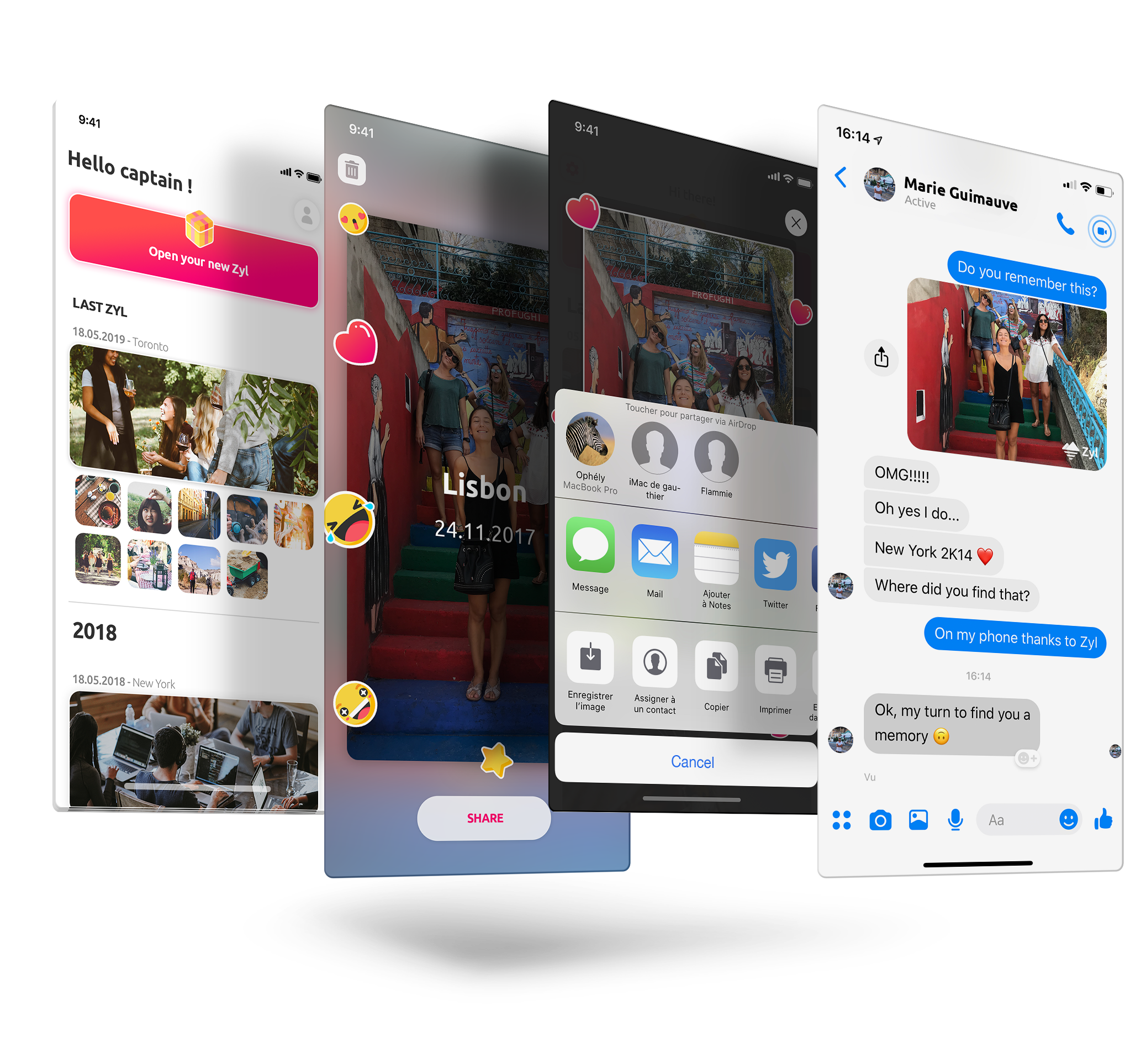
It’s also worth noting that Zyl processes your photo library on your iPhone or Android device directly. Photos aren’t sent to the company’s server.
Up next, Zyl plans to enrich your collection of Zyls with more photos and videos from your friends and family. You could imagine a way to seamlessly share photos of the same life event with your loved ones, even if they are currently spread out over multiple smartphones.
With today’s funding round, the company wants to improve the app and reach millions of users. Zyl already has impressive retention rates, with 38% of users opening the app regularly during five weeks or more.
Powered by WPeMatico
Apple is set to announce new iPhone models today. The company is holding a keynote on its campus at 10 AM PT (1 PM in New York, 6 PM in London, 7 PM in Paris). And you’ll be able to watch the event right here as the company is streaming it live.
Update: And it’s over. The video of the event isn’t up just yet (Update 2: the video is up), but head over to our coverage of the event:
Rumor has it that the company plans to unveil three new smartphones. The iPhone 11 should replace the iPhone XR in the lineup, while the iPhone 11 Pro and 11 Pro Max should replace the iPhone XS and XS Max respectively.
Apple could also update the Apple Watch with a new titanium version. You can also expect to get the release date of iOS 13, iPadOS 13, tvOS 13, macOS Catalina and watchOS 6. Let’s see if Apple announces the launch dates of Apple TV+ and Apple Arcade as well.
When it comes to less likely announcements that could still happen, Apple has been working on new MacBooks, a new Apple TV with a more powerful system-on-a-chip and new iPads. All eyes are on the new iPhone, but Apple could use today’s conference to announce those other products.
You can watch the live stream directly on this page. For the first time, Apple is streaming its conference on YouTube.
If you have an Apple TV, you can download the Apple Events app in the App Store. It lets you stream today’s event and rewatch old ones. The app icon was updated a few days ago for the event.
And if you don’t have an Apple TV and don’t want to use YouTube, the company also lets you live-stream the event from the Apple Events section on its website. This video feed now works in all major browsers — Safari, Microsoft Edge, Google Chrome and Mozilla Firefox.
Of course, you also can read TechCrunch’s live blog if you’re stuck at work and really need our entertaining commentary track to help you get through your day. We have a team in the room.
Powered by WPeMatico
Today, social networks Twenty and Mappen are joining together in a merger under the Twenty brand.
From the beginning, Twenty’s goal has been to get young people off of their phones and out in the real world with their friends. Twenty connects users with their friend groups and lets them browse fun experiences, from concerts to sports games to movies, with an easy UI for coordinating a group and making it happen. In fact, Twenty has forged relationships with orgs like Live Nation, Endeavor, Roc Nation and Tao, which collectively produce 10,000+ events a year with an audience of more than 100 million fans.
Mappen, on the other hand, is a location-based social network that let users share what they were doing (and where they were doing it) with their friends. For example, users could give a status update using a Fortnite emoji tagged to their house, inviting friends to come over and play a few games.
The two companies have been in talks, and collaborating, for the past nine months looking for ways to bring the experiences together. Where Twenty has relationships with experience providers, Mappen had the audience of young people looking to connect with each other.
The end result is an all-stock deal that unifies the user experience under the Twenty brand name.
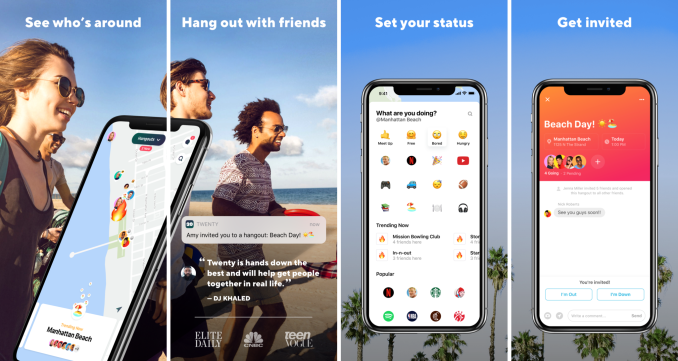
Though the announcement of the merged app didn’t go down until today, the two apps have been combined for a while, and CEO Diesel Peltz says the new app has seen 33% month over month growth in new users. Hangouts have increased 50% from July to August. Peltz will lead the combined company as CEO.
For now, the new Twenty does not have a business model in place. However, the plan is to use the event partnerships to generate revenue as opposed to ads, which relies on eyeballs on screens.
“If the model is solely based on ads, you want the users to spend as much time on the platform as possible,” said Peltz. “We’re looking to create a different opportunity for people to access these experiences.”
Thus far, the combined Twenty has raised approximately $40 million from partners, including Accel, Maveron, 500 Startups and Sound Ventures, as well as Roc Nation, Live Nation and Endeavor.
Powered by WPeMatico
Glance, a subsidiary of Indian mobile ad business firm InMobi, said today it has raised $45 million as it prepares to scale its business outside of India and bulk up its product offerings.
The unnamed maiden financing round for Glance was funded by Mithril Capital, a growth-stage investment firm co-founded by Silicon Valley investors Peter Thiel and Ajay Royan.
In an interview with TechCrunch, Naveen Tewari, founder and CEO of InMobi Group, said the current round has not closed and could bag another $30 million to $55 million in the next two months.
Glance operates an eponymous service that shows media content in local languages on the lock screen of Android-powered smartphones. InMobi has partnered with a number of top smartphone vendors, including Xiaomi, Samsung and Gionee, to integrate Glance into their respective operating systems.
Glance, which was launched in September last year and supports English, Hindi, Tamil and Telugu, has amassed 50 million monthly active users in India, its primary market. Users are spending an average of 22 minutes with Glance each day, he said.
“All the new smartphone models launched by Samsung, Xiaomi and a handful of other vendors have launched with Glance on them,” Tewari said.
In a statement, Mithril Capital’s Royan said, “We share Glance’s global vision of breaking through the constraints of application architectures and linguistic markets to deliver rich, frictionless, and engaging experiences across a myriad of cultures and languages.” As part of the financing round, he is joining Glance’s board.
Glance does not show traditional ads, something it intends to never change, but shows a certain kind of content to drive engagement for brands.
In the months to come, Glance plans to expand the platform and bring short-form videos (Glance TV), and mini games (Glance Games) to the lock screen. It is also working on a feature dubbed Glance Nearby that will enable brands to court users in their vicinity, and Glance Shopping to explore ways to build commerce around content.
As of today, InMobi Group is not monetizing Glance platform, but plans to explore ways to make money from it early next year, Tewari said.
The 12-year-old firm said it plans to expand footprints of Glance outside of India. The company plans to take Glance to some Southeast Asian markets like Malaysia, Indonesia and Thailand. InMobi’s Tewari said Glance has already started to find users in these markets.
InMobi Group, which had raised $320 million prior to today’s financing round, has been profitable for several years, but the company decided to raise outside funding to accelerate Glance’s growth, Tewari said.
The firm, which has three subsidiaries, including its marquee marketing cloud division, plans to go public in the next few years. But instead of taking the entire group public, Tewari said the firm is thinking of publicly listing each division as they mature. The marketing cloud division, which brings in the vast majority of revenue for the firm, will go public first, he said.
“The IPO plans remain, and we will evaluate them as we go along. The reality, however, is that the market is so big and there is so much room that we can continue to be private for a few more years,” he said.
Powered by WPeMatico
Microsoft several years ago acquired the popular iOS app Wunderlist with the intention of building out its own list-making productivity app that brings the best of Wunderlist’s feature set to a larger group of mobile consumers. This is a similar path as Microsoft took with email app Accompli, which later became Microsoft Outlook for mobile devices. In the case of Wunderlist, Microsoft didn’t just rebrand the app — it built a new one called Microsoft To Do. With Wunderlist up and running for years alongside To Do, its founder wants to know if he can just have it back.
The founder of Wunderlist maker 6Wunderkinder, Christian Reber, recently tweeted a desire to buy his app back from Microsoft just as the company is launching a new version of To Do.
According to the tweets, Reber says he’s serious about reacquiring Wunderlist and wants to make it open-source and free. He even tweeted a list of upgrades he’d like to build, including features like shared folders and cross-team collaboration, among other things.
Still sad @Microsoft wants to shut down @Wunderlist, even though people still love and use it. I’m serious @satyanadella @marcusash, please let me buy it back. Keep the team and focus on @MicrosoftToDo, and no one will be angry for not shutting down @Wunderlist. pic.twitter.com/27mIABncLF
— Christian Reber (@christianreber) September 6, 2019
What I would do with @Wunderlist if I would get it back: pic.twitter.com/DYslu8mhOp
— Christian Reber (@christianreber) September 8, 2019
The founder doesn’t come across as having sour grapes exactly. He just says he’s sad that his plans for Wunderlist didn’t work out, but he’s grateful for the Microsoft exit.
If anything, it seems to be just remorse over the fact that Wunderlist itself will be shut down.
Want to make one thing clear: I feel nothing but gratitude for @Microsoft and everyone involved in the @Wunderlist acquisition in 2015. It made perfect sense, definitely the best thing that ever happened to us. The team there is amazing, I’m friends with many of them. 1/2
— Christian Reber (@christianreber) September 8, 2019
Microsoft had said years ago this was its intention, but also that it would hold off until it felt it has a competitive product that Wunderlist’s users would love.
On Monday, Microsoft unveiled another upgrade for Microsoft To Do, which hints that the Wunderlist shut down could be nearing.
The upgrade delivers a more polished look-and-feel with a wider range of backgrounds, including the Berlin TV tower theme that was popular in Wunderlist.
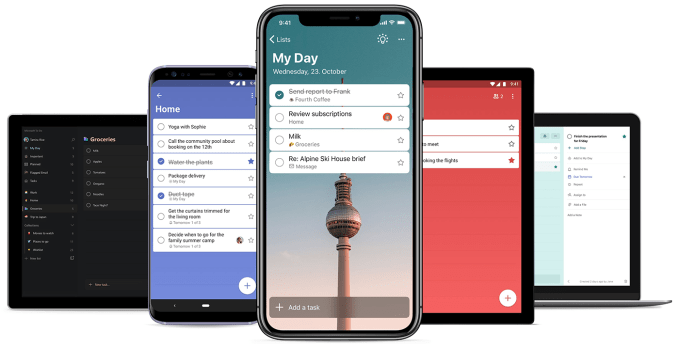
The app also includes smart lists and a personalized daily planner that offers smart suggestions of tasks that need to be accomplished, Microsoft reminded its users, and it’s supported across a variety of platforms, including iOS, Android, Windows and Mac.
The app is now also integrated with other Microsoft apps like Outlook, Microsoft Planner, Cortana and Microsoft Launcher on Android, among others. And it works with Alexa, if you prefer.
With the release, Microsoft is again pushing users to migrate from Wunderlist to To Do to gain access to these features.
It did not, however, give an end-of-life date for Wunderlist, which is remarkably still a top 100 Productivity app in the U.S. App Store, according to data from App Annie, over four years after its acquisition.
We’ve asked Microsoft if it will share more details around its plans for Wunderlist and if it has any response to Reber’s request.
“Once we have incorporated the best of Wunderlist into Microsoft To Do, we will retire Wunderlist. We look forward to making Microsoft To Do even more useful, intuitive and personal,” a Microsoft spokesperson replied. The company declined to comment on Reber’s tweets.
Microsoft To Do has been installed approximately 5.8 million times worldwide since launch, according to data from Sensor Tower. During that same time frame, Wunderlist was installed about 10 million times.
As for Reber, he says he’s written to Microsoft many times before and now tried to make it more official via Twitter. The offer, he tells TechCrunch, is indeed serious, and the price would be based on the negotiation. “Chances are low, but I’m trying,” he says.
Powered by WPeMatico
That Apple has used its App Store to offer itself a competitive advantage is nothing new. TechCrunch and others have been reporting on this problem for years, including those times when Apple chose to display its apps in the No. 1 position on the Top Charts, for example, or when it stole some of the App Store’s best ideas for its own, banned apps that competed with iOS features or positioned its apps higher than competitors in search. Now, in the wake of antitrust investigations in the U.S. and abroad, as well as various anti-competitive lawsuits, Apple has adjusted the App Store’s algorithm so fewer of its own apps would appear at the top of the search results.
The change was reported by The New York Times on Monday, which presented Apple with a lengthy analysis of app rankings.
It even found that some searches for various terms would display as many as 14 Apple-owned apps before showing any results from rivals. Competitors could only rank higher if they paid for an App Store search ad, the report noted.
That’s a bad look for Apple, which has recently been trying to distance itself and its App Store from any anti-competitive accusations.
In May, for example, Apple launched a new App Store website designed to demonstrate how it welcomes competition from third-party apps. The site showed that for every Apple built-in app, there were competitors available throughout the App Store.
But availability in the store and discoverability by consumers are two different things.
Apple admitted to the NYT that for over a year many common searches on the App Store would return Apple’s own apps, even when the Apple apps were less popular or relevant at times. The company explained the algorithm wasn’t manipulated to do so. For the most part, Apple said its own apps ranked higher because they’re more popular and because they come up in search results for many common terms. The company additionally said that one feature of the app’s algorithm would sometimes group apps by their maker, which gave Apple’s own apps better rankings than expected.
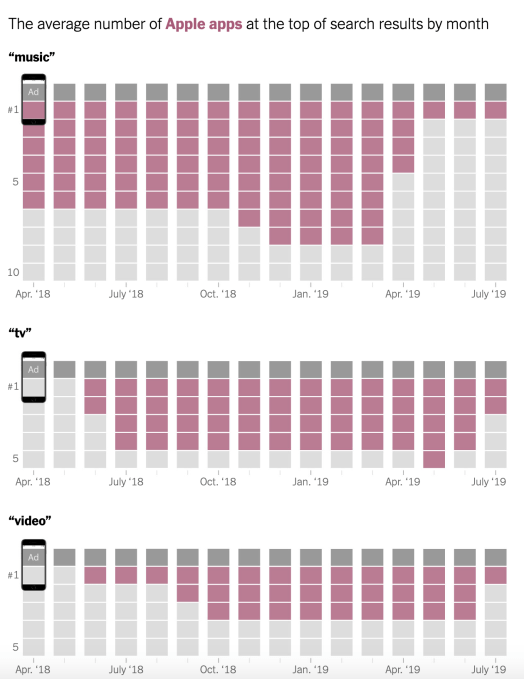
Above: via the NYT, the average number of Apple apps that returned at the top of the search results by month
Apple said it adjusted the algorithm in July to make it seem like Apple’s own apps weren’t receiving special treatment. According to the NYT, both Apple VP Philip Schiller, who oversees the App Store, and SVP Eddy Cue, who oversees many of Apple’s apps, confirmed that these changes have not fully fixed the problem.
The issue, as Apple explains it, is that its own apps are so popular that it had to tweak its algorithm to pretend they are not. Whether or not this is true can’t be independently verified, however, as Apple doesn’t allow any visibility into metrics like searches, downloads or active users.
Maybe it’s time for Apple’s apps to exit the App Store?
The report, along with the supposed ineffectiveness of the algorithm’s changes, begs the question as to whether Apple’s apps should show up in the App Store’s charts and search results at all, and if so, how.
To be fair, this is a question that’s not limited to Apple. Google today is facing the same problem. Recently, the CEO of a popular software program, Basecamp, called Google’s paid search ads a “shakedown,” arguing that the only way his otherwise No. 1 search result can rank at the top of the search results page is to buy an ad. Meanwhile, his competitors can do so — even using his brand name as the keyword to bid against.
The same holds true for the App Store, but on a smaller scale than the entirety of the web. That also makes Apple’s problem easier to solve.
For example, Apple could simply choose to offer a dedicated section for its own software downloads, and leave the App Store as the home for third-party software alone.
This sort of change could help to eliminate concerns over Apple’s anti-competitive behavior in the search results and chart rankings. Apple might balk against this solution, saying that users should have an easy way to locate and download its own apps, and the App Store is the place to do that. But the actual marketplace itself could be left to the third-party software while the larger App Store app — which today includes a variety of app-related content, including app reviews, interviews with developers, app tips and a subscription gaming service, Apple Arcade — could still be used to showcase Apple-produced software.
It could just do so outside the actual marketplace.
Here’s how this could work. If users wanted to re-install an Apple app they had deleted or download one that didn’t come pre-installed on their device, they could be directed to a special Apple software download page. Pointers to this page could be in the App Store app itself as well as in the iOS Settings.
An ideal spot for this section could even be on the existing Search page of the App Store.
With a redesign, Apple could offer a modified search screen where users could optionally check a box to return a list of apps results that would come only from Apple. This would indicate intentional behavior on the consumer’s part. That is, they are directly seeking an Apple software download — as opposed to the current situation where a user searches for “Music” and sees Apple’s own music app appear above all the others from rivals like Spotify and Pandora.
Alternately, Apple could just list its own apps on this page or offer a link to this dedicated page from the search screen.
And these are just a few variations on a single idea. There are plenty of other ways the App Store could be adjusted to be less anti-competitive, too.
As another example, Apple could also include the “You Might Also Like” section in its own apps’ App Store listings, as it does for all third-party apps.
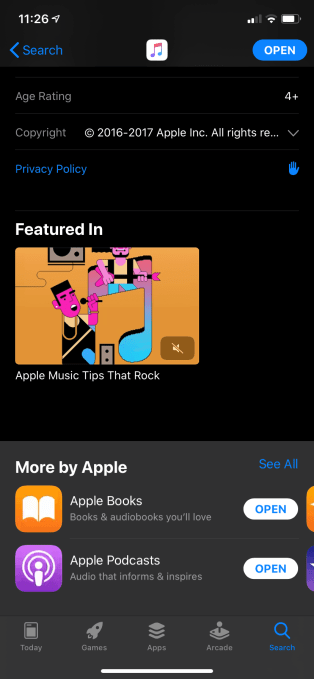 Above: Apple Music’s App Store Listing
Above: Apple Music’s App Store Listing
This section directs users to other apps that match the same search query right within the app’s detail page. Apple’s own apps, however, only include a “More by Apple” section. That means it’s keeping all the search traffic and consumer interest for itself.
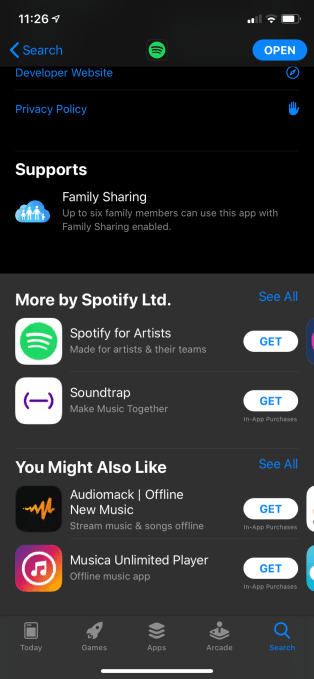
Above: Spotify’s App Store Listing
Or it could reduce the screen space dedicated to its own apps in the search results — even if they rank higher — in order to give more attention to apps from competitors while still being able to cater to users who were truly in search of Apple’s software.
But ultimately, how Apple will have to behave with regard to its App Store may be left to the regulators to decide, given Apple’s failure to bake this sort of anti-competitive thinking into its App Store design.
Powered by WPeMatico
Fully autonomous cars may (or may not) be just around the corner, but in the meantime, a startup that’s building in-car apps to help human drivers pass the time when behind the wheel has raised a round of funding.
Drivetime — which makes voice-based trivia quizzes, games and interactive stories that people can play while driving — has raised $11 million in funding led by Makers Fund (a prolific investor in gaming startups), with participation from Amazon (via the Alexa Fund) and Google (via its Assistant investment program).
The startup today has eight “channels” on its platform consisting of games and stories that you can access either within a limited free-to-play tier or via a paid subscription ($9.99 a month or $99.99 a year). The plan is to use the funding to continue expanding that catalog, as well as investing in deeper integrations with its new big-name strategic investors, who themselves have longstanding and deep interests in bringing more voice services and content to the in-car experience.
Co-founder and CEO Niko Vuori told TechCrunch that his ultimate ambition is for Drivetime to become “the Sirius XM of interactive content” for cars, with hundreds of different channels of content.
In keeping with those plans, along with the funding, Drivetime is today announcing a key content deal.
It has teamed up with the long-running, popular game show Jeopardy to build a trivia channel for the platform, which lets drivers test their own skills and also play against other drivers and people they know. The Jeopardy channel will source content from the TV show’s trove of IP and come with another familiar detail: it will be narrated by Alex Trebek, with a new quiz getting published every weekday for premium users.
That social element of the Jeopardy game is not a coincidence. The San Francisco-based startup is founded by Zynga alums, with Vuori and his co-founders Justin Cooper and Cory Johnson also working together at another startup called Rocket Games since leaving the social games giant and exiting that to gaming giant Penn National for up to $170 million. That track record goes some way to explaining the strong list of investors in the new startup.
“Social and interactive formats are the next frontier in audio entertainment,” said Makers Fund founding partner Jay Chi, in a statement. “Niko, Justin Cooper and Cory Johnson, with a decade-long history of working together and a proven track record in building new platforms, is the best team to bring this idea to life.”
“Gaming and entertainment are among customers’ favorite use cases for Alexa, and we think those categories will only grow in popularity as Alexa is integrated into more vehicles,” said Paul Bernard, director of the Alexa Fund at Amazon, in a separate statement. “Drivetime stands out for its focus on voice-first games in the car, and we’re excited to work with them to broaden the Alexa Auto experience and help customers make the most of their time behind the wheel.”
In addition to the three investors in this latest round, prior to this Drivetime had raised about $4 million from backers that include Felicis Ventures, Fuel Capital, Webb Investment Network (Maynard Webb’s fund) and Access Ventures.
Vuori declined to say how many installs or active users the app has today — although from the looks of it on AppAnnie, it’s seeing decent if not blockbuster success on iOS and Android so far.
Instead, the company prefers to focus on another stat, its addressable market, which it says is 110 million drivers in North America alone.
Meanwhile, adding a Jeopardy channel is building on what has worked best so far. The most popular category at the moment is trivia, with Tunetime (a “name that tune” game) coming in second and storytelling a third.
Drivetime’s premise is an interesting one. Drivers are a captive audience, but one that has up to now had a relatively limited amount of entertainment created for it, focusing mainly on music and spoken word.
However, the rise of voice-based interfaces and interactivity using natural language — spurred by the rise of personal assistant apps and in-home hubs like Amazon’s Echo — have opened a new opportunity, developing interactive, voice-based content for drivers to engage with more proactively.
You might think that this sounds like a recipe for a car accident. Won’t a driver get too distracted trying to remember the fourth president of the United States, or who was known as the father of the Constitution? (Hint: It’s the same guy.)
Vuori claims it’s actually the reverse: Having an interactive game that requires the driver to speak out loud can focus him or her and keep the driver more alert.
“We are double-dipping in safety,” he said. “On the one hand, we embody the safety aspects of Alertness Maintaining Tasks (AMTs). But we also act as a preventative, meaning that while players engage with Drivetime, they are not engaging with anything else.”
While the content today may serve as a way of keeping drivers from doing things they shouldn’t be doing while in a car, there is another obvious opportunity that might come as drivers become less necessary and will need other things to occupy themselves.
Longer term, the Jeopardy deal could usher in other channels based on popular game shows. Sony Pictures Television Games, which owns the rights to it, also owns Wheel of Fortune and Who Wants to Be a Millionaire.
“We are thrilled to work with Sony Pictures Television Games to bring Jeopardy, the greatest game show on the planet, to an underserved audience that desperately needs interactive entertainment the most – the 110 million commuters in North America driving to and from work by themselves every day,” said Vuori said in a statement.
Interestingly, despite the growth of “skills” for Alexa or apps for Google Home and other home hubs, and the overall popularity of these as a way of interacting with apps and sourcing information, Vuori says that he hasn’t seen any competition emerge yet from other app developers to build voice-based entertainment for drivers in the way that Drivetime has.
That gives the company ample opportunity to continue picking up new users — and more deals with publishers and content companies looking for more mileage (sorry) for their legacy IP and new business.
“Drivetime is one of the early pioneers in creating safe, stimulating entertainment for drivers in the car,” Ilya Gelfenbeyn, founding lead of the Google Assistant Investments Program, noted in a statement. “More and more people are using their voice to stay productive on the road, asking the Google Assistant on Android and iOS phones to help send text messages, make calls and access entertainment hands free. We share Drivetime’s vision, and look forward to working with their team to make the daily commute more enjoyable.”
Powered by WPeMatico
Vivaldi has long billed itself as a browser for advanced users who want to be able to customize their browser to their heart’s content. With that mission, it managed to get a foothold in the desktop market, but until now, the browser company co-founded by Opera’s former CEO Jon von Tetzchner didn’t have a presence on mobile. That’s changing today with the launch of Vivaldi for Android, which retains the browser’s look, feel and speed without getting bogged down in trying to bring all its myriad features to mobile.
For the most part, I like to use the same browser on desktop and mobile, simply to keep my bookmarks in sync (and Vivaldi says it doesn’t use Google’s servers to sync, in case you’re worried about being tracked). For the longest time, that was one of the reasons I always switched away from Vivaldi on the desktop, despite the fact that the browser is essentially made for a user like me. With the mobile version, I think that’ll change.
The overall browser experience is pretty straightforward. I appreciate the fact that the Vivaldi team put all of the standard UI features (backward, forward, tab switcher and URL/search) at the bottom. You can still use the address bar at the top of the screen and the menu, too, of course, but in this age of giant screens, I appreciate a browser that can be used with one hand for much of the time.
As far as features go, Vivaldi covers all the bases, with speed dials and bookmarks, some advanced tab management features that aren’t usually available on mobile, including the ability to clone tabs, and a screenshots feature that lets you capture either the full page or just the visible area. If you regularly use different search engines, you also can use Vivaldi’s shortcuts in the address bar (think ‘d’ for DuckDuckGo, for example). There’s also a reader view and pretty much everything else you expect from a modern mobile browser.
One area where I’d like to see a bit more work from Vivaldi in general, both on mobile and desktop, is tracking protection. That’s been a focus for Firefox in many of its recent releases and even Microsoft’s new Chrome-based Edge browser is offering the ability to block trackers by default. Vivaldi, at least in its current form, doesn’t yet provide any tracking protection by default. That’s not much of an issue on the desktop, where you can easily install an extension, but on mobile, I’d like the company to do a bit more.
Overall, Vivaldi on Android is a worthwhile contender. It’s fast and easy to use — and if you’re already using Vivaldi on the desktop, it’s a no-brainer. Even if you’re not, it’s still worth a shot and may just get you to try the desktop version, too.
Powered by WPeMatico
Google Search can now help you find your next binge. The company this morning announced a new feature that will make personalized recommendations of what to watch, including both TV shows and movies, and point you to services where the content is available.
The feature is an expansion of Google’s existing efforts in pointing web searchers to informative content about TV shows and films.
Already, a Google search for a TV show or movie title will include a “Knowledge Panel” box at the the top of the search results where you can read the overview, see the ratings and reviews, check out the cast and, as of spring 2017, find services where the show or movie can be streamed or purchased.
The new recommendations feature will instead appear to searchers who don’t have a particular title in mind, but are rather typing in queries like “what to watch” or “good shows to watch,” for example. From here, you can tap a Start button in the “Top picks for you” carousel to rate your favorite TV shows and movies in order to help Google better understand your tastes.
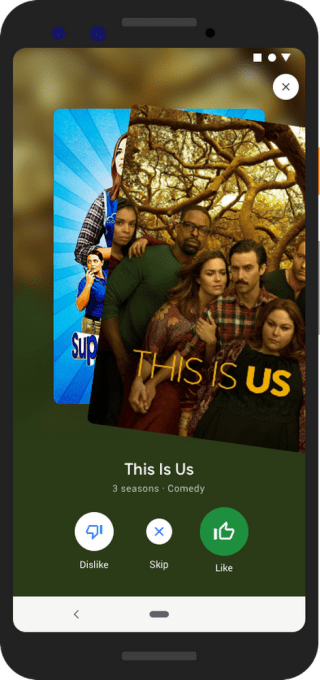
You also can select which subscriptions you have access to, in order to customize your recommendations further. This includes subscription services like Netflix, Hulu, HBO GO and HBO NOW, Prime Video, Showtime, Showtime Anytime, CBS All Access and Starz.
You also can indicate if you have a cable TV or satellite subscription. And it will list shows and movies available for rent, purchase or free streaming from online marketplaces like iTunes, Prime Video, Google Play Movies & TV and Vudu, plus network apps like ABC, Freeform, Lifetime, CBS, Comedy Central, A&E and History.
To get started, you’ll use a Tinder-like swiping mechanism to rate titles. Right swipes indicate a “like” and left swipes indicate a “dislike.” You can “skip” titles you don’t know or have an opinion on.
After giving Google some starter data about your interests, future searches for things to watch will offer recommendations tailored to you.
The company tells TechCrunch this information is only being used for the purpose of recommendations — it’s not being offered to advertisers. Instead, it’s about Google’s larger goal in helping people find the information they need.
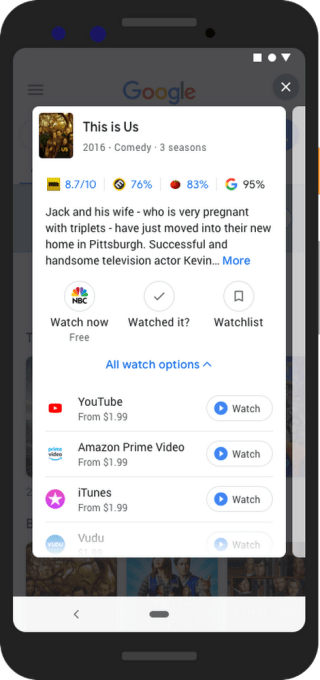
The company notes that you can even get specific with your requests, by asking for things like “horror movies from the 80s” or “adventure documentaries about climbing.” (This will help, too, when you can’t remember a movie’s title but do know what it’s about.)
Google’s search results will return a list of suggestions, and when you pick one you want to watch, the service will — as before — let you know where it’s available.
The company already has a good understanding of consumer interest in movies and TV thanks to its data on popular searches. Now it aims to have a good understanding of what individual users may want to watch, as well.
The new recommendations feature is live today on mobile for users in the U.S.
Powered by WPeMatico